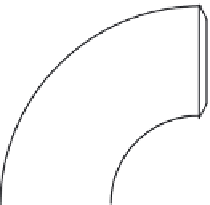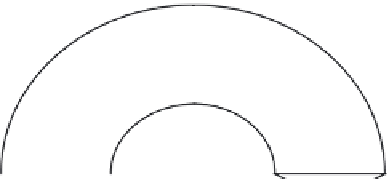Environmental Engineering Reference
In-Depth Information
D
D
Short-radius
Long-radius
figure 4.27 Short- and long-radius elbows.
4.12.2.1 Changing the Direction of Flow
Usually, a 45° or 90°
elbow
(or “ell”) fitting is used to change the
direction of flow. Elbows are among the most commonly used fittings
in piping and are occasionally used in tubing systems. Two types of
90° elbows are shown in Figure 4.27. From the figure, it is apparent that
the
long-radius
fitting (the most preferred elbow) has the more gradual
curve of the two. This type of elbow is used in applications where the
rate of flow is critical and space presents no problem. Flow loss caused
by turbulence is minimized by the gradual curve. The
short-radius
elbow (see Figure 4.27) should not be used in a system made up of long
lines that has many changes in direction. Because of the greater fric-
tional loss in the short-radius elbow, heavier, more expensive pumping
equipment may be required. Figure 4.28 shows a
return bend
fitting that
carries fluid through a 180° (“hairpin”) turn. This type of fitting is used
for piping in heat exchangers and heater coils. Note that tubing, which
can be bent into this form, does not require any fittings in this kind of
application.
4.12.2.2 Providing Branch Connections
Because they are often more than single lines running from one
point to another point, piping and tubing systems usually have a num-
ber of intersections. In fact, many complex piping and tubing systems
resemble the layout of a town or city.
D
figure 4.28 Long-radius return bend.



















